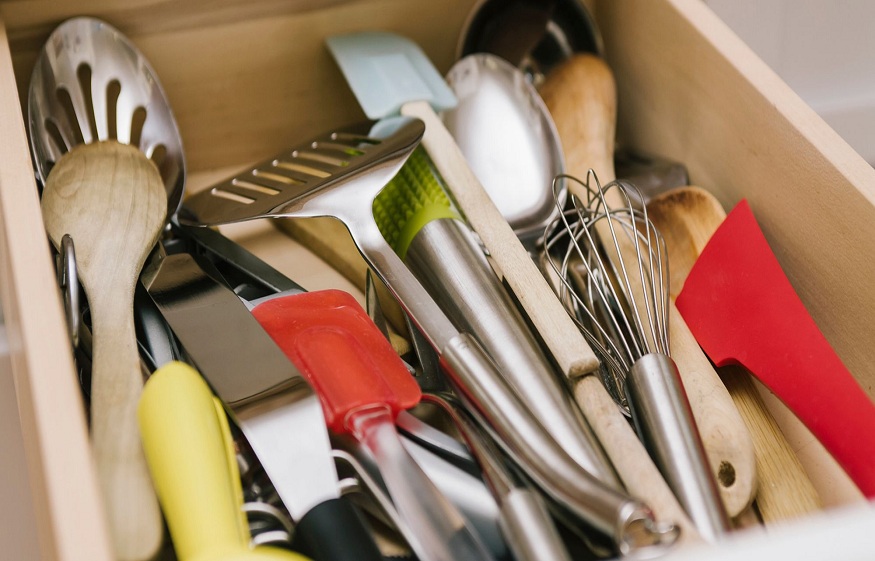
An alloy of iron, chromium, carbon and nickel, it is the material most used in the chemical industry. This already says a lot about its degree of resistance and its total chemical inertness (absence of reaction/migration whatever the context). However, there are different types of stainless steel. The one most commonly found for the kitchen is 10/18 stainless steel. These figures indicate respectively the percentages of nickel and chromium, standards established by the European Union. It is also possible to find 18/0 stainless steel, free of nickel. The latter is a little less robust, but beneficial in case of nickel allergy. “Stainless steel remains in any case a safe bet from a sanitary point of view . It is also unbreakable, easy to maintain and 100% recyclable ”, assures Bernard Petit, chemical engineer and member of the RES. But if you find that the food sticks more on the stainless steel, “add a little oil to the bottom of the pan, this will limit this effect and also allow a better distribution of the heat, for a more beneficial cooking of the food”, advises Dr. Chevalier, nutritionist.
Another very good student which, like stainless steel, has easily found its place in the chemical industry thanks to its degree of solidity coupled with its perfect inertia. In the kitchen, therefore, no problem either. Borosilicate glass, popularized by the Pyrex brand, can withstand temperatures up to 500°C without side effects. We can just blame it for being more fragile than other materials . If it falls, it breaks. It can also lose its shiny appearance after a few passages in the dishwasher. (But that’s really quibbling!)
The Pyrex that we love: Rectangular Pyrex oven dish.
“It’s only true”, as our grandmothers would say. And they are right! An alloy of iron and carbon, cast iron is not only a real must for gentle and long cooking, but it is also able to sear food without risk to health . “It is a safe material from a chemical point of view. Iron atoms can come off, oxidation can also be observed, but this is of no consequence. The inertia can also be improved by an enamel coating, but on condition that this enamel is of good quality”, notes Bernard Petit.
If in doubt about the quality of the enamel, opt for natural cast iron. And for a quality product, choose French brands, which comply well with European standards, unlike others. “We have already seen Asian manufacturers produce casseroles with cast iron radiators, containing traces of heavy metals,” recalls Bernard Petit. Other strengths: its durability and performance that improves over time. The fats used on cast iron end up patinating it ( this phenomenon is called seasoning), which promotes the distribution of heat and increases the quality of cooking. Although expensive, cast iron proves to be an investment for several decades. However, its poor maneuverability may limit its use.
Our favorite cast iron dish: Invicta round cocotte
Wood, a material of the future?
He has been criticized a lot for not being hygienic enough. “But it has been shown that after traditional cleaning, bacteria do not grow faster on wood than on plastic .“says Bernard Petit. Innocent, it even appears today as one of the best materials to use for the protection of the environment. “In this period of ecological and energy transition, it must be favored over plastics, which come from non-renewable fossil oil sources. Inra publications (presented at the 2017 General Food Conference) also indicate that wood makes it possible to store CO2, and reduce greenhouse gases, compared to oil production”, specifies Bernard Petit. Be careful, however, to choose only raw, natural wooden utensils that have not undergone any chemical protection treatment. “Information on possible treatments is often insufficient, or even absent, so ask the sellers carefully!” Dr. Chevallier insists.
Iron, a little taste of coming back to it?
Fashionable among “greens” lately, this rather rustic material remains reliable from a sanitary point of view. And it is very cheap. Only concern, it leaves a taste to food (but without this representing any toxicity). The problem can also be reduced if an iron cake pan is lined beforehand with parchment paper. In iron pans (which require seasoning), on the other hand, it is difficult to escape this slight aftertaste. The ideal remains to wash the iron with hot water, to dry it well, then to apply a small blow of an oiled cloth to it. Notice to cleanliness freaks.
Copper, only for jams
A good thermal conductor, copper must nevertheless remain confined to decoration and jams! “Copper remains a very reactive material chemically, which is why its use cannot be generalized in all utensils”, notes Bernard Petit. Its usefulness ultimately finds legitimacy only in the making of jams, for which its copper ions, combined with the acidity of the fruits, can promote gelling, according to the work of Hervé This, of INRA. “It is also credited with antifungal qualities capable of slowing down the appearance of mould”, emphasizes Bernard Petit. At very low doses, it also remains an essential trace element for our body. But it becomes dangerous in larger quantities.
Kitchen utensils: materials to banish.Plastics, always cold
First rule if you have plastic containers: never cook them (oven, microwave). And this is even more true if these containers were purchased before the ban on bisphenol A in food containers (in January 2015) or outside the European Union.

